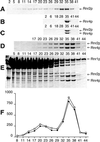Yeast ribonucleotide reductase has a heterodimeric iron-radical-containing subunit
- PMID: 10716984
- PMCID: PMC15953
- DOI: 10.1073/pnas.97.6.2474
Yeast ribonucleotide reductase has a heterodimeric iron-radical-containing subunit
Abstract
Ribonucleotide reductase (RNR) catalyzes the de novo synthesis of deoxyribonucleotides. Eukaryotes have an alpha(2)beta(2) form of RNR consisting of two homodimeric subunits, proteins R1 (alpha(2)) and R2 (beta(2)). The R1 protein is the business end of the enzyme containing the active site and the binding sites for allosteric effectors. The R2 protein is a radical storage device containing an iron center-generated tyrosyl free radical. Previous work has identified an RNR protein in yeast, Rnr4p, which is homologous to other R2 proteins but lacks a number of conserved amino acid residues involved in iron binding. Using highly purified recombinant yeast RNR proteins, we demonstrate that the crucial role of Rnr4p (beta') is to fold correctly and stabilize the radical-storing Rnr2p by forming a stable 1:1 Rnr2p/Rnr4p complex. This complex sediments at 5.6 S as a betabeta' heterodimer in a sucrose gradient. In the presence of Rnr1p, both polypeptides of the Rnr2p/Rnr4p heterodimer cosediment at 9.7 S as expected for an alpha(2)betabeta' heterotetramer, where Rnr4p plays an important role in the interaction between the alpha(2) and the betabeta ' subunits. The specific activity of the Rnr2p complexed with Rnr4p is 2,250 nmol deoxycytidine 5'-diphosphate formed per min per mg, whereas the homodimer of Rnr2p shows no activity. This difference in activity may be a consequence of the different conformations of the inactive homodimeric Rnr2p and the active Rnr4p-bound form, as shown by CD spectroscopy. Taken together, our results show that the Rnr2p/Rnr4p heterodimer is the active form of the yeast RNR small subunit.
Figures




References
-
- Reichard P. Annu Rev Biochem. 1988;57:349–374. - PubMed
-
- Reichard P. Science. 1993;260:1773–1777. - PubMed
-
- Thelander L, Reichard P. Annu Rev Biochem. 1979;48:133–158. - PubMed
-
- Lycksell P-O, Ingemarson R, Davis R, Gräslund A, Thelander L. Biochemistry. 1994;33:2838–2842. - PubMed
-
- Elledge S J, Davis R W. Genes Dev. 1990;4:740–751. - PubMed
Publication types
MeSH terms
Substances
LinkOut - more resources
Full Text Sources
Medical
Molecular Biology Databases

